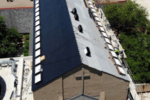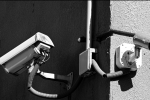November 2002
Buildings and Grounds
Keep the Plaster out of the Soup
Last year, I asked five clergy –- evangelical and mainline Protestant, Roman Catholic, Episcopal, and Jewish -– to record a short meditation from their own tradition that answered the question, Why should we spend money on our buildings when there is so much need in the world?
What could have been a lame joke beginning "there were two ministers, two priests, and a rabbi…" instead resulted in a moving recording in which they tackled the question from Scripture, tradition, and experience. They all agreed that we are called to be good stewards of our buildings, not because they are our material possessions but because they are fundamental tools of our ministry.
Confusing landmarks with presence
We Episcopalians do a good job of creating and designating landmarks. Historically, we’ve had the financial wherewithal to afford the best architects, building materials, and furnishings for our churches. The National Register of Historic Places lists Episcopal churches far out of proportion to our actual presence; the same holds true for state and local registers. Indeed, officials of the New Jersey Trust for Historic Preservation say that, if their preservation grants told the true story of the state’s religious character, they’d believe that everyone was either an Episcopalian or Quaker. We have, however, gotten our landmark buildings confused with buildings that mark our presence in community and therein lies the rub.
Marking place
Our churches mark place. From slender colonial spires that once guided ships into eastern ports to the bulky towers of our Gothic cathedrals, our churches dominate the urban landscape. Our forebears wanted to make a statement: "We are here!"
Tiny rural gems like the Bishop Weed churches in Florida and the Bishop Whipple ones in Minnesota catch us by surprise and with delight. Churches are visual anchors in a community whether they dominate the urban streetscape or sit in a grove of trees on a country road, often surrounded by a churchyard.
Our neighbors expect our churches to be there. They pause when the bells ring, they set their watches by the tower clock, and they are our building’s guardians when we are not around. Many graffiti artists and burglars have been thwarted in their work by neighbors who "own" the church under siege even if they’ve never been inside the front doors.
Marking memory
Our churches mark memory. Whenever I visit Gethsemane Cathedral in Fargo, I am struck by how this modern building, resembling the grain elevators that break the North Dakota skyline, recalls those fearless Episcopalians who settled the unforgiving prairie. Artifacts from the cathedral train that crossed the state at the turn of the century have been incorporated into Gethsemane’s design as have stained glass windows from the former downtown Fargo cathedral that was lost to fire. We need these memories to anchor us in our tradition and to link us to those who ministered before and those who will follow.
Marking ministry
Our churches mark ministry. Drive down Philadelphia’s Germantown Avenue and look up. You will see a sign marking one church’s presence in a desperate neighborhood: "We’re in Germantown for good."
This bold proclamation celebrates 150 years of service and a successful $2.5 million capital campaign to restore the parish hall that houses an array of social service programs.
Our churches open their doors selflessly to the community and every time one closes or removes deteriorating space from use, day care centers, Scout programs, and 12-Step meetings must find a new home. Partners for Sacred Places’ ground-breaking national research on the public value of older and historic religious properties shows that congregations provide an annual average of $140,000 of value to the community through the programs and services they house.
We’ve gone on the defensive about spending money on our buildings — to restore them or even keep them in good repair. To avoid charges of idolatry, we use our resources to feed the hungry all the while ignoring the plaster that is falling into the soup pot. As vestry members, we to rethink our priorities to ensure that our buildings serve our neighbors and us well.
My own parish just finished $3 million dollars of restoration and repair work (as one vestry member put it, 100 years of deferred maintenance!) We struggle with our operating budget each year; it is an easy call to put off dealing with drainage problems when our programs are growing by leaps and bounds. Or so it seems, until the church school classrooms in the undercroft are flooded yet again.
Worthy of the call
As vestry members, we are the physical stewards of our buildings. They represent one of the greatest assets we have, not only in terms of their financial value but also by what they allow us to do to serve others. Our community knows us by our buildings and how we use them as tools for our ministry. We are called to be good stewards for the present and for the future. Let us be worthy of that call.
A vestry member of St. Martin’s-in-the-Fields in Philadelphia, Pennsylvania, Sarah Peveler is also the Director of Special Projects of the Philadelphia-based Partnership for Sacred Places, a national non-profit, non-sectarian organization promoting the stewardship of older and historic religious properties.





